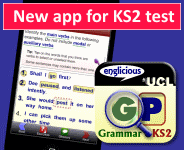Explanation
A conjunction links two words or phrases together.
There are two main types of conjunctions:
- coordinating conjunctions (e.g. and) link two words or phrases together as an equal pair.
- subordinating conjunctions (e.g. when) introduce a subordinate clause.
- James bought a bat and ball. [links the words bat and ball as an equal pair]
- Kylie is young but she can kick the ball hard. [links two clauses as an equal pair]
- Everyone watches when Kyle does back-flips. [introduces a subordinate clause]
- Joe can't practise kicking because he's injured. [introduces a subordinate clause]
The principal coordinating conjunctions are and, or and but) and some typical subordinating conjunctions are because, when, that, if, whether, for).
The 2016 GPaS test sample papers also refer to conjunctions as joining words.
Englicious contains many resources for English language in schools, but the vast majority of them require you to register and log in first. For more information, see What is Englicious?

